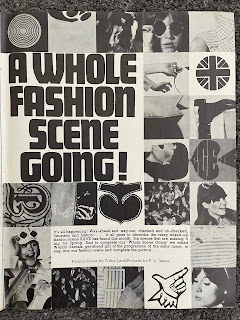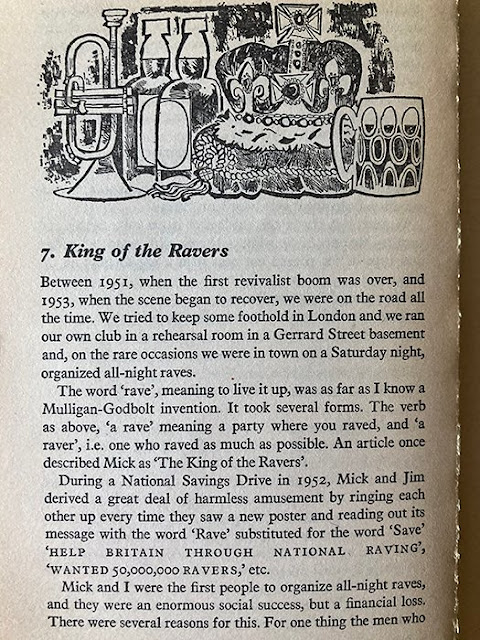In this Guardian piece around Raving, McKenzie Wark cites me as suggesting that the word "rave" might originate in Jamaican music culture.
And it's true - the word did have currency in early reggae and sound system culture. Bob Marley and the Wailer's "Midnight Ravers". Steel Pulse's "Ravers".
But I also say, in Energy Flash, that the all-night rave was a concept in psychedelia.
Then there's The Yardbirds's Having a Rave Up with the Yardbirds - the rave up as the part of a tune where the tempo jumps and the playing gets frenzied.
Not forgetting Buddy Holly's "Rave On!".
In fact in the U.K, the idea of being a raver or going to a rave dates back to the trad jazz era - the all-night dance parties of the late 1940s and 1950s: young people dancing wildly to bands playing a hyped-up version of New Orleans hot jazz.
Supposedly the introduction of these terms came from the musician Mick Mulligan, known as "The King of the Ravers".
But as I say in the earlier post, Mulligan didn't pick these words out of thin air. "Rave" has centuries worth of English language connotations to do with enthusiasm, madness, excessive excitement, intoxication, uncontrol, delirium, disinhibition, fervour, and half-a-dozen other shades of meaning applicable to the all-night, drug-fueled party.
But here's another British example of rave and raver as having currency in the 1960s: the pop magazine Rave, which was founded in 1964 and targeted at young women.
"Raver" at that time seemed to have a meaning specifically related to the idea of a young woman breaking free of inhibitions and social constraints - a suggestion of unbridled adventurousness and thrill-seeking. Abandon - and abandonment of the expected standards of appropriate feminine behaviour and sexual continence.
This "raver" is the archetype hymned in the Troggs's "Wild Thing", in John's Children's "Sara Crazy Child", Rolling Stones's "Ruby Tuesday". (Bowie's "Rebel Rebel" is simply an early '70s update, with appropriately Stonesy music, of this exaltation of the androgyne free spirit.)Not forgetting "She's Leaving Home".
A similar idea on the other side of the pond can be found in The Doors's "Wild Child" ("not your mother or your father's child / you're our child") and (with a gentler, mystical expression) in the convention-flouting heroines of The Byrds's "Why" and "She Don't Care About Time".
The instinctual insurrection of the screaming tweenage girls during Beatlemania and Stonesfrenzy... coming to a kind of consciousness in late adolescence and early twenties. From the raw eruption of eros to an erotic politics. From maenad to handmaiden of revolution. That is a shift tracked in the magazine Rave as it goes from a teenybop mag full of full-color pin-ups of everygirl's fave rave, to something nearer the counterculture.
This April 1968 issue of Rave presents London as the city of ravers.


This earlier "rave" scene had its own club scene - discotheques
And just like the '90s London rave scene, it was fueled by pirate radio (at least until the Labour government banned it towards the end of 1967)
Imagined scenarios involving young girls being preyed upon while under the influence of E and LSD circulated during the acid house tabloid scaremongering of 1988-89 - a flashback to the scenarios (often wholly invented) to do with acid in the 1960s.
Which were just like the stories circulated in the 1920s about flappers, cocaine, and hot jazz.
More pages from the April 1968 issue of Rave
x
Before even this, though









.jpg)

















"Kick out the Jams with the Beatles": what's the date of that issue? And do you know the first usage of "kick out the jams"?
ReplyDeleteThat's a July 1969 issue. The MC5's debut was released in the UK in June, so it would have been front of mind for the editorial team at the time.
ReplyDeleteApparently "kick out the jams" was an MC5 coinage, meaning exactly what it sounds like it means. See Brother Wayne Kramer here:
https://en.wikipedia.org/wiki/Kick_Out_the_Jams#:~:text=We%20first%20used%20the%20phrase,the%20jams%2C%20meaning%20stop%20jamming.
Amazingly Rave magazine carried on until September 1971 - I can't imagine how they would have negotiated the heavy 'n' hairy era of blues boom, acid rock, prog, singer-songwriter etc - the absolute dearth of pin-ups. Already it's looking a bit uneasy with that cover featuring Beatles in beards and mustaches and the Kick out The Jams slogan.
ReplyDeleteAnd then they puttered out of existence just as T. Rex brought back the 'fave rave' teenybop thing.
There's an archive of some of the magazine's run here
https://worldradiohistory.com/Rave.htm
I also have the September 71 issue on pdf from somewhere - the last ever one - and it's an odd mix of stuff - Biba, a column by on Kid Jensen, a profile of Adam Faith.